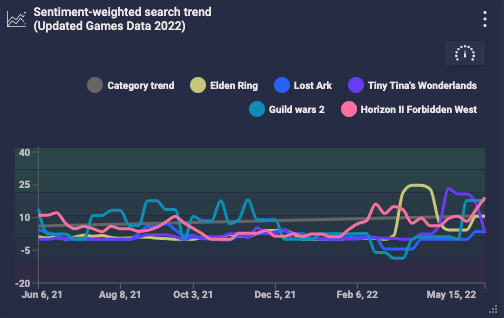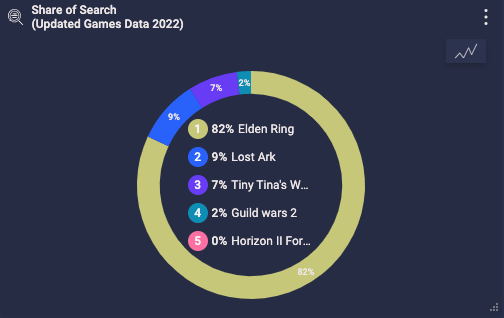How Gaming Companies Can Use “Share of Search” to Track Trends
When publisher Bandai Namco Entertainment released their latest game, Elden Ring, it became the most talked about title in the industry. Yet weeks later, copies of Elden Ring flooded reseller markets, and gamers took to their platforms to declare that they were rage-quitting the game and selling their copies out of sheer frustration, opting for other newly released titles and buying Elden Ring second-hand. This isn’t the first time Elden Ring game developer FromSoftware has been called out for creating games that cause people to throw their controllers at their consoles; their 2012 title Dark Souls was critically acclaimed, yet labeled as one of most notoriously difficult games to beat that year.
What could Bandai Namco learn from this situation in order to keep users buying newer copies of their game? Rather than relying on focus groups, expensive industry research, or sentiment data collected on titles from over a decade ago, the answer of how to keep market share and continue to make money selling new copies of Elden Ring lies in examining one key metric: Share of Search.
What Is Share of Search?
In an increasingly digital world, a new metric has emerged as a more accurate measurement of consumer and business purchasing intent and demand for products: Share of Search. There is no better way to measure a consumer’s intent to purchase than to measure what they search on the web.
To calculate a brand’s Share of Search, you can take the number of organic searches your brand received during a specific period, and divide it by the number of searches all the brands in your industry received at that time. Several tools will be able to measure this for you, and some even have the capability to track this Share of Search over time to visualize how market share can change over time.
Research has shown that Share of Search is the most accurate measurement of consumer and business purchasing intent and demand. For the first time, businesses can use AI/Machine Learning and big data to track consumer interest in buying their products and their competitors’ products and why. Want to know your competitors’ market share or your own? Share of Search represents, on average, 83% of a brand’s market share.
Share of Search, when combined with other data like sentiment search, tells a full story of where brands stand in the market based on what people search for. As an example, we can see here from these charts provided by My Telescope that Elden Ring dominates the conversation on search with 82% market share - but sentiment about the brand took a massive dip after gamers realized that the game was so difficult to beat and started selling their copies. This provides valuable trend information to businesses looking to understand how people’s thoughts toward the brand might translate into long-term business success.
How Share of Search Helps Gaming Companies
While hundreds of tools exist to measure marketing effectiveness for short-term sales and ROI, historically it has been difficult to measure how this short-term success actually translates into long-term brand loyalty.
Advertising veteran and Founding Chairman of MDC Media Partners (now Stagwell's Assembly Global) Steve Farella, who has spent nearly four decades in the media industry, recognized this as a leading problem in the marketing industry, and recently joined the board of directors for leading market intelligence and search technology leader My Telescope to address this issue.
“A massive issue that has always existed in advertising and marketing is that there has not been a universal metric that measures the impact of media and advertising on purchasing and decision intent – until now,” said Farella.
Research done by the IPA found that Share of Search acted as a strong proxy for the consumer demand side of market share, and that Share of Search is dynamic; when one changes, the other changes. Additionally, when brand sentiment is measured alongside share of search, it creates a complete picture of what the future might look like in terms of how a brand might stack up against their competitors. This means that no matter the industry, brands can accurately measure the trends of the market using real-time data to predict consumer buying behavior.
For example, by looking at Share of Search plus weighted sentiment data, gaming publishers could see that while Elden Ring dominates the conversation with 86% share of search on Google, sentiment around those searches is in heavy decline, giving them insight into how to pivot their marketing efforts to amplify sales of new copies of the game.
According to the IPA’s research, branded search metrics have been proven to have a direct correlation with sales, with an average correlation of 83%. This means that if a search increases by 100%, the sales for that brand or topic increases by 83%. The remaining difference can be explained by influencing factors such as price or supply issues.
Farella states that by analyzing this data, marketers can get a better idea of how their investments in marketing campaigns might play out over time. This benefits all aspects of advertising from understanding trends that might affect creative decisions to helping media buyers understand how much money they may want to invest in their campaigns to achieve ROI and increase their share of the market in the long run.
“By investing in a tool that uses search and sentiment analysis for proven forecasting of business demand, brands will finally be able to take actionable insights that increase ROI and create sustainable, repeatable campaigns that drive business success,” said Farella.
Conclusion
By leveraging Share of Search tools, like My Telescope, which uses 20 different data modeling tools like Share of Search, Google search volumes, and weighted sentiment analysis, gaming companies can track consumer interest to make more informed decisions about their marketing spend and where to heighten their efforts to reach new customers and strengthen loyalty with existing ones. Agencies of all sizes and Fortune 500 companies have already begun adopting this metric as an advertising standard in order to more effectively predict their market potential. As familiarity with Share of Search continues to grow, it may be poised to become the universal standard metric of campaign success that marketers have been looking for all along.



